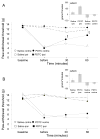Role of NFkappaB in an animal model of complex regional pain syndrome-type I (CRPS-I)
- PMID: 19878863
- PMCID: PMC4531089
- DOI: 10.1016/j.jpain.2009.04.012
Role of NFkappaB in an animal model of complex regional pain syndrome-type I (CRPS-I)
Abstract
NFkappaB is involved in several pathogenic mechanisms that are believed to underlie the complex regional pain syndrome (CRPS), including ischemia, inflammation and sensitization. Chronic postischemia pain (CPIP) has been developed as an animal model that mimics the symptoms of CRPS-I. The possible involvement of NFkappaB in CRPS-I was studied using CPIP rats. Under sodium pentobarbital anesthesia, a tourniquet was placed around the rat left ankle joint, producing 3 hours of ischemia, followed by rapid reperfusion (IR injury). NFkappaB was measured in nuclear extracts of muscle and spinal cord tissue using ELISA. Moreover, the anti-allodynic (mechanical and cold) effect was tested for systemic, intrathecal, or intraplantar treatment with the NFkappaB inhibitor pyrrolidine dithiocarbamate (PDTC). At 2 and 48 hours after IR injury, NFkappaB was elevated in muscle and spinal cord of CPIP rats compared to shams. At 7 days, NFkappaB levels were normalized in muscle, but still elevated in spinal cord tissue. Systemic PDTC treatment relieved mechanical and cold allodynia in a dose-dependent manner, lasting for at least 3 hours. Intrathecal-but not intraplantar-administration also relieved mechanical allodynia. The results suggest that muscle and spinal NFkappaB plays a role in the pathogenesis of CPIP and potentially of human CRPS.
Perspective: Using the CPIP model, we demonstrate that NFkappaB is involved in the development of allodynia after a physical injury (ischemia and reperfusion) without direct nerve trauma. Since CPIP animals exhibit many features of human CRPS-I, this observation indicates a potential role for NFkappaB in human CRPS.
Figures



References
-
- Alexander GM, van Rijn MA, van Hilten JJ, Perreault MJ, Schwartzman RJ. Changes in cerebrospinal fluid levels of pro-inflammatory cytokines in CRPS. Pain. 2005;116(3):213–219. - PubMed
-
- Atreya I, Atreya R, Neurath MF. NF-kappaB in inflammatory bowel disease. J Intern Med. 2008;263:591–596. - PubMed
-
- Barnes PJ, Karin M. Nuclear factor-kappaB: a pivotal transcription factor in chronic inflammatory diseases. N Engl J Med. 1997;336:1066–1071. - PubMed
-
- Birklein F, Schmelz M, Schifter S, Weber M. The important role of neuropeptides in complex regional pain syndrome. Neurology. 2001;57:2179–2184. - PubMed
-
- Birklein F, Weber M, Ernst M, Riedl B, Neundorfer B, Handwerker HO. Experimental tissue acidosis leads to increased pain in complex regional pain syndrome (CRPS) Pain. 2000;87:227–234. - PubMed
Publication types
MeSH terms
Substances
Grants and funding
LinkOut - more resources
Full Text Sources
Medical

